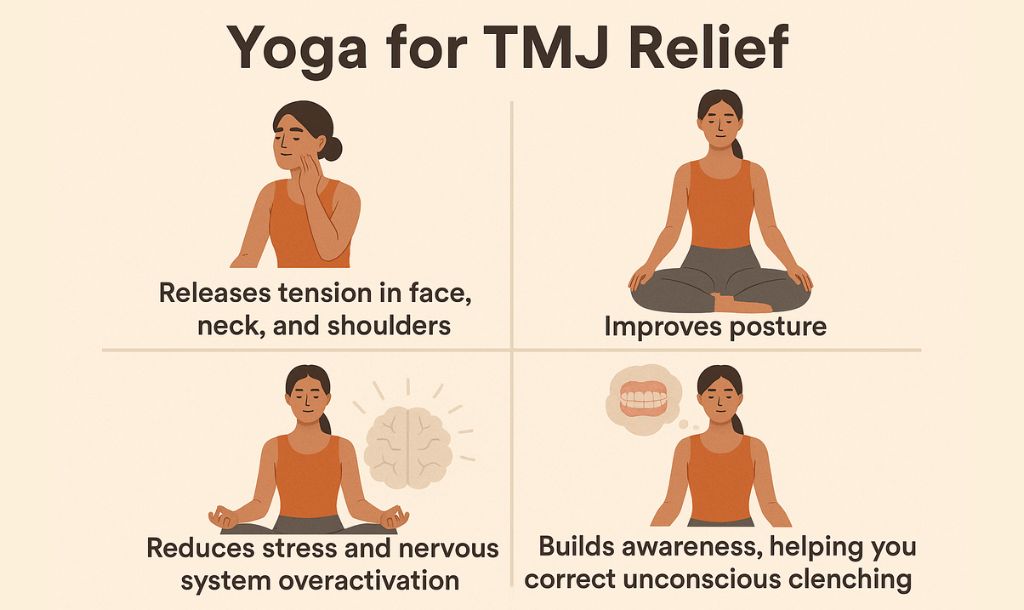What is Happy Baby Pose (Ananda Balasana)?
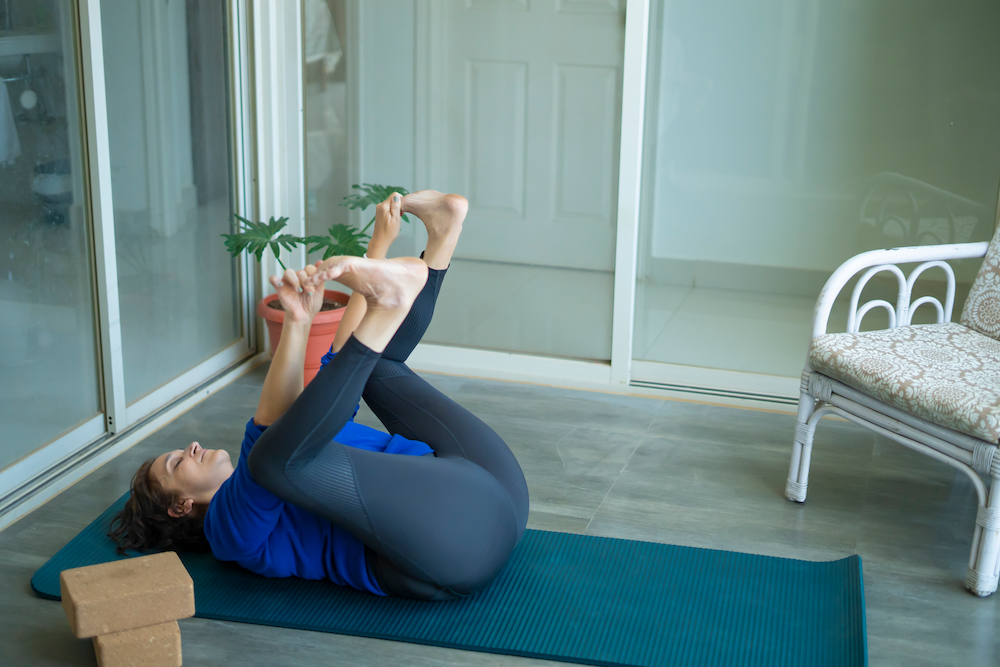
Happy Baby Pose (Ananda Balasana) is a gentle, reclined yoga posture where you lie on your back and hold the outsides of your feet, resembling a joyful baby at play. It’s one of the most beginner-friendly hip-opening yoga poses, helping relieve lower back tension, stretching the inner thighs and hamstrings, and calming the mind through deep, steady breathing.
Ideal for beginners, evening routines, or anyone with tight hips, Happy Baby Pose promotes relaxation, improves flexibility, and supports better posture. It’s often practiced at the end of a yoga session to release tension and prepare the body for rest.
Happy Baby Pose: Overview & Meaning of Ananda Balasana
In Sanskrit, Ananda means “bliss” or “happiness”, Bala means “baby or child”, and Asana means “pose” or “posture.” Together, Ananda Balasana translates to “Pose of the Blissful Baby.” The name beautifully reflects the sense of ease, surrender, and playful curiosity that this posture brings — reminding us to approach practice with softness rather than strain.
Unlike many other yoga poses, Happy Baby Pose is a more recent addition to modern yoga. It was inspired by the natural movements of a baby holding its feet — a universal symbol of joy, innocence, and freedom of the body. As yoga evolved in the 20th century to include more accessible, therapeutic postures, Happy Baby became a favorite for promoting relaxation and emotional release.
Today, it’s widely used in Hatha, Restorative, and Yin Yoga classes for its calming effect on the nervous system and gentle opening of the hips and spine.
At a Glance
- Sanskrit Name: आनन्द बालासन (Ananda Balasana)
- Pronunciation: ah-NAHN-dah bah-LAHS-anna
- English Names: Happy Baby Pose, Happy Baby, Joyful Baby Pose
- Pose Type: Supine hip opener, restorative, stress relief
- Level: Beginner (accessible to most practitioners)
- Duration: 30 seconds to 5 minutes
Benefits of Happy Baby Pose
Whether you’re winding down after work, starting your day with gentle movement, or preparing for deeper stretches, this pose offers something for everyone.
Physical Benefits
Happy Baby Pose is a powerful yet gentle hip opener that counteracts the effects of sitting and stiffness from daily life.
- Releases tight hips: Stretches the inner thighs, adductors, and hip flexors.
- Eases lower back tension: The gentle pulling motion creates spinal traction that relieves compression.
- Improves flexibility: Regular practice increases the range of motion in the hips and hamstrings.
- Supports better posture: Helps lengthen the spine and improve pelvic alignment.
- Relieves sciatica: Gentle hip opening may reduce nerve pressure (when practiced mindfully).
- Opens the shoulders: Encourages release in the upper back and shoulder blades.
Mental & Emotional Benefits
Beyond physical release, Happy Baby Pose also supports emotional well-being and mindfulness.
- Calms the nervous system: The reclined position and deep breathing activate the parasympathetic response.
- Reduces stress and anxiety: Encourages relaxation through physical openness.
- Invites joy and playfulness: The childlike posture softens tension and sparks a lighter mood.
- Improves sleep quality: Perfect for bedtime practice or restorative yoga.
- Enhances body awareness: Teaches you to observe tension patterns with compassion.
Therapeutic Applications
Happy Baby Pose is widely used in therapeutic and restorative yoga for its ability to ease tension without overexertion.
- Lower back pain relief: Gentle spinal decompression soothes chronic tightness.
- Tight hips from sitting: Perfect counter-stretch for desk workers.
- Insomnia or restlessness: Promotes deep relaxation and better sleep when practiced before bed.
- Anxiety and emotional stress: Grounding and calming for the mind.
- Menstrual discomfort: Helps release pelvic tension (with gentle movement).
- Mild sciatica: Provides relief through gradual hip opening.
- Digestive support: The gentle pressure on the abdomen can aid digestion.
- Prenatal & postpartum support – Safe in early pregnancy and beneficial for hip recovery (with modifications).
Reap these benefits with 1-on-1 coaching. Learn Happy Baby Pose today!
How to Do Happy Baby Pose (Ananda Balasana): Step-by-Step Guide
Part 1: Preparing for the Pose
Before getting into the pose, spend 3–5 minutes warming up your hips and back.
1. Supine Knee-to-Chest Pose (Apanasana)
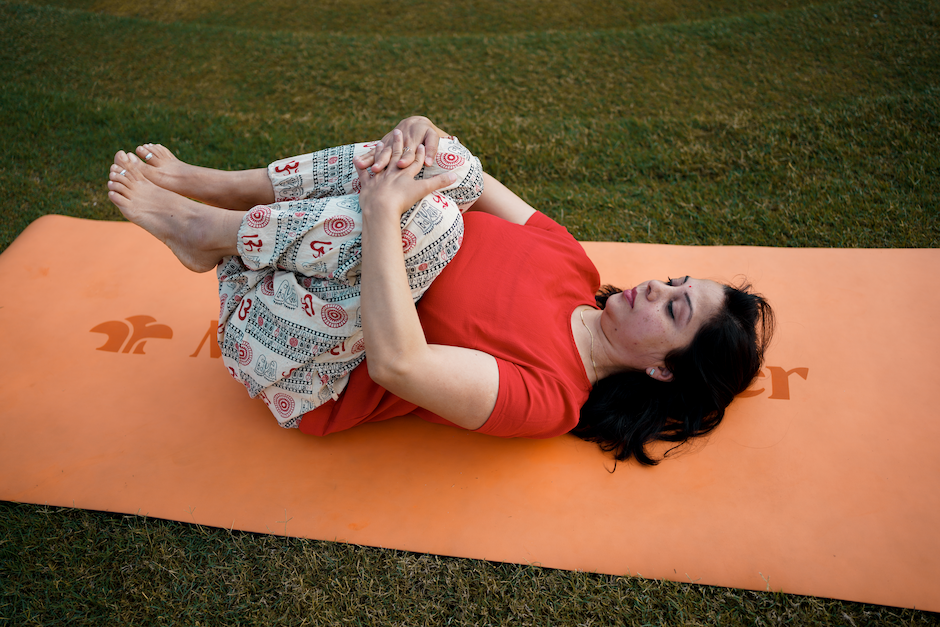
Relieves tension and stiffness in the lower back while calming the mind.
- Lie on your back with your legs extended.
- On an exhale, draw one or both knees toward your chest and gently hug them in with your hands.
- Keep your shoulders relaxed and breathe deeply into your lower back.
2. Reclined Butterfly Pose (Supta Baddha Konasana)
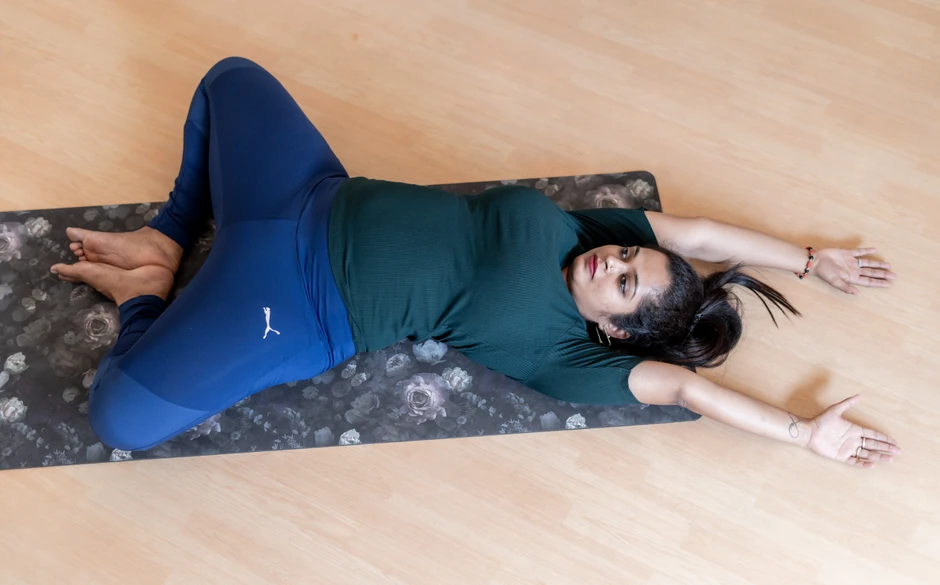
Opens the inner thighs and hips, promoting deep relaxation and grounding.
- Lie on your back and bring the soles of your feet together, letting your knees fall open to the sides.
- Rest your hands on your belly or by your sides, breathing slowly into your hips.
- Use props under your thighs if needed for support.
3. Wind-Relieving Pose (Pavanamuktasana)
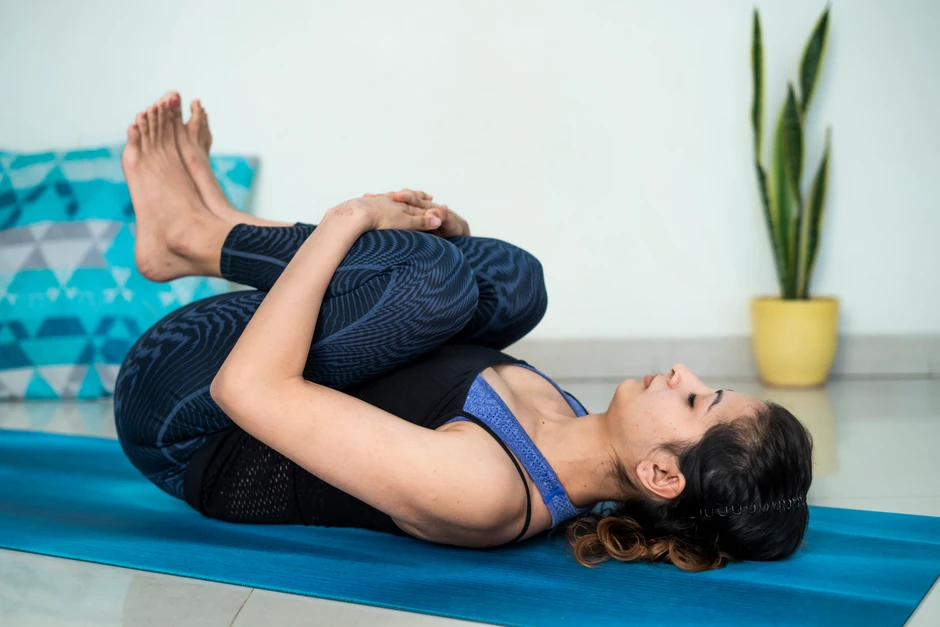
Softens the hips and lower back while aiding digestion and relieving bloating.
- Lie on your back, bend one knee toward your chest, and clasp your hands around the shin.
- Gently pull the knee closer as you exhale, pressing your lower back into the mat.
- Switch sides or hug both knees for a fuller stretch.
4. Gentle Hip Circles
Lubricates the hip joints and improves mobility before deeper stretches.
- Lie on your back with knees bent and feet flat on the floor.
- Draw small, slow circles with your knees together or one at a time, keeping your movements smooth and controlled.
- Coordinate the motion with steady breathing.
Part 2: How to Do Happy Baby Pose: Step-by-Step Instructions
- Lie flat on your back on your yoga mat. Relax your shoulders, arms, and neck. Take a few slow breaths to settle.
- Exhale and bring both knees toward your chest. Hug them gently, feeling your lower back press into the mat.
- Separate your knees wider than your torso, drawing them toward your armpits. Flex your feet and point the soles toward the ceiling.
- Thread your hands inside your legs and grab the outer edges of your feet (pinky-toe side). If that’s difficult, use a yoga strap or hold your ankles or thighs instead.
- Gently position your ankles directly above your knees, creating a 90° angle in your legs. Flex your feet actively, pressing them slightly into your hands.
- Pull your feet down toward the floor while keeping your lower back grounded. Let your hips open and spine lengthen naturally.
- Hold the pose and breathe deeply into your belly. You may rock side to side to massage your spine.
- Beginners: 30 seconds – 1 minute
- Intermediate: 1–3 minutes
- Restorative practice: 3–5 minutes
- Release your feet, bring your knees together, and hug them to your chest.
- Extend your legs flat on the mat and rest for a few breaths.
Alignment & Safety Tips
- Keep your lower back on the mat — don’t force knees to armpits.
- Flex your feet to protect your knees and hips.
- Hold ankles or thighs if you can’t reach your feet — never strain.
- Keep shoulders and neck relaxed throughout.
- If pregnant, avoid lying flat after the first trimester.
- If you feel pain (not mild stretching), slowly release and rest.
To learn the pose with expert 1-on-1 guidance, book your free session today!
Happy Baby Pose Variations
Happy Baby Pose (Ananda Balasana) can be adapted for every body type, flexibility level, and intention — whether you’re a complete beginner or a seasoned yogi. These variations allow you to explore the pose safely, release tension at your own pace, and make it either more restorative or more active.
Beginner Modifications
1. Strap-Assisted Happy Baby
Perfect for beginners or those with tight hamstrings. This variation makes the pose accessible without strain.
- Lie on your back and loop a yoga strap or belt around each foot.
- Hold the strap ends and gently draw your knees toward your chest.
- Keep your lower back grounded and breathe deeply to relax into the stretch.
2. Hold Ankles, Calves, or Thighs Instead of Feet
Ideal for those with limited flexibility. It keeps your spine neutral and reduces pressure on your knees.
- Lie back and bend your knees, bringing them toward your chest.
- Reach for your ankles, calves, or the backs of your thighs instead of your feet.
- Gently pull your legs down toward your torso without arching your back.
3. One-Legged Happy Baby
Great for beginners or anyone with uneven hip tightness. It releases one hip at a time safely.
- Extend one leg flat on the mat while holding the other foot in Happy Baby position.
- Keep the extended leg relaxed and your lower back grounded.
- Breathe evenly, then switch sides.
Intermediate Variations
1. Rocking Happy Baby
Great for releasing spinal tension. This version adds movement and a playful rhythm.
- Once in Happy Baby Pose, gently rock side to side along your spine.
- Keep movements slow and controlled, breathing naturally.
- Let the motion massage your back muscles and calm your mind.
2. Extended Leg Variation
Best for deepening flexibility. This variation stretches hamstrings and opens hips.
- From Happy Baby, straighten one leg toward the ceiling while holding the other foot.
- Keep the extended leg active and your back flat on the mat.
- Switch sides after several breaths.
3. Half Happy Baby with Twist
Excellent for spinal mobility — combines hip opening with a gentle twist.
- Hold one foot in Happy Baby position and extend the other leg across your body.
- Keep your shoulders grounded as you rotate slightly.
- Hold for 3–5 breaths, then switch sides.
Advanced Variations
1. Bound Happy Baby
Designed for advanced practitioners. It strengthens the core and intensifies hip opening.
- From Happy Baby, bring your knees closer together while still holding your feet.
- Engage your core slightly to stabilize your position.
- Maintain deep, even breathing as you hold.
2. Happy Baby to Shoulder Stand Transition
Great for advanced yogis. This variation builds core strength and supports inversion prep.
- From Happy Baby, release your feet and rock back gently onto your shoulders.
- Extend both legs upward toward the ceiling.
- Engage your core for control and stability as you transition.
Happy Baby Pose (Ananda Balasana): Precautions & Contraindications
While Happy Baby Pose is considered one of yoga’s safest and most beginner-friendly postures, it still requires mindfulness — especially if you have certain health conditions, joint issues, or are pregnant.

Book a free 1-on-1 session with a certified Indian yoga teacher to learn how to adapt Happy Baby Pose for your body!
Avoid Happy Baby Pose If You Have:
- Recent hip or knee surgery: The deep bend may stress healing tissues.
- Acute knee injury: The bent-knee position can aggravate inflammation.
- Severe neck or shoulder injury: Supine position may cause discomfort.
- High blood pressure (uncontrolled): Mild inversion may affect circulation.
- Pregnancy (2nd or 3rd trimester): Lying flat on your back can restrict blood flow.
- Groin strain or tear: The pose stretches the inner thighs intensely.
- Advanced osteoporosis: The hip rotation and compression may pose a fracture risk.
Practice with Caution or Modifications If You Have:
- Pregnancy (1st trimester): Usually safe with props; always consult your doctor or a prenatal yoga coach first.
- Tight hamstrings: Use a strap or hold your thighs instead of your feet.
- Lower back sensitivity: Keep movements gentle and avoid pulling hard.
- Knee discomfort: Ensure ankles are stacked over knees and feet stay flexed.
- Hip replacement: Move carefully; avoid deep external rotation unless approved by your surgeon.
- Sacroiliac (SI) joint issues: Practice gently — Happy Baby can help or aggravate depending on alignment.
- During menstruation: Generally safe, but some practitioners prefer to avoid lying flat.
Safety Guidelines
To make your practice both effective and injury-free:
- Never force the stretch — let gravity and time do the work.
- Keep your lower back grounded; avoid arching excessively.
- Flex your feet to protect your knees.
- Use props (straps, blankets, bolsters) freely for support.
- Breathe continuously — smooth, deep, relaxed breaths enhance release.
- Stop immediately if you feel sharp or pinching pain.
Happy Baby Pose: Related Yoga Poses
1. Reclined Pigeon Pose (Supta Kapotasana) or Figure-4 Stretch
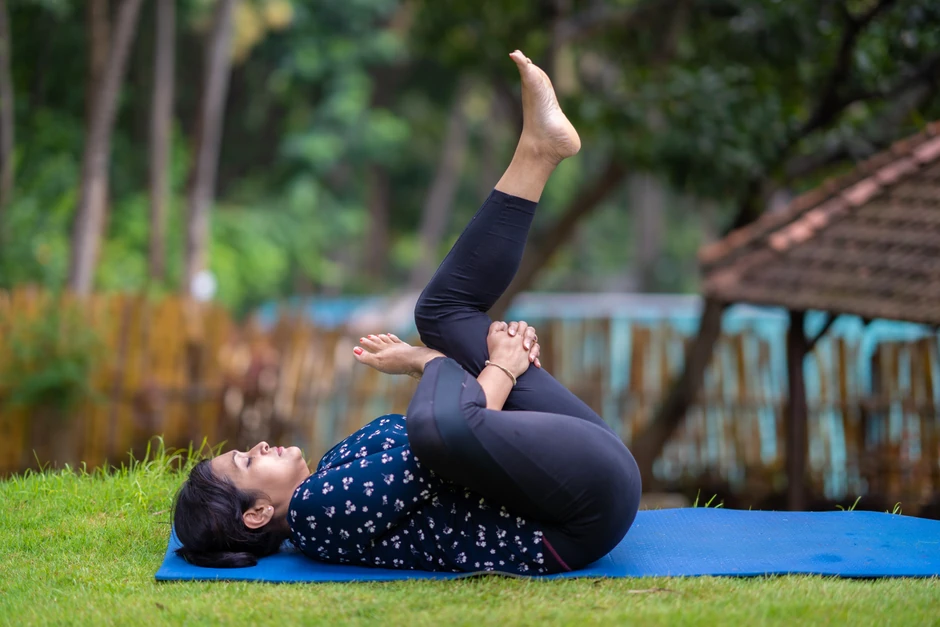
Deeply opens the outer hips and glutes — great for releasing tension from sitting.
- Lie on your back with knees bent and feet on the floor.
- Cross your right ankle over your left thigh, forming a figure-4 shape.
- Gently draw your left knee toward your chest, holding the back of your thigh.
- Keep your shoulders relaxed and breathe deeply into the outer right hip.
2. Reclined Hand-to-Big-Toe Pose (Supta Padangusthasana)
Stretches the hamstrings and improves hip mobility — ideal for enhancing flexibility.
- Lie on your back and extend your right leg toward the ceiling.
- Loop a yoga strap or use your hand to hold your big toe.
- Keep the opposite leg grounded on the mat.
- Breathe deeply, gently drawing the raised leg closer without straining.
3. Reclined Spinal Twist (Supta Matsyendrasana)
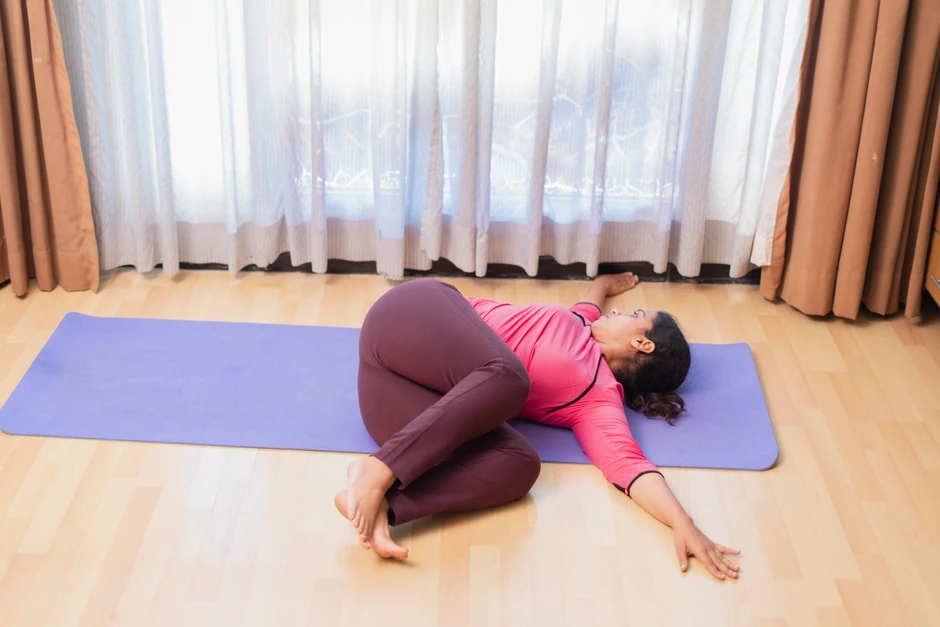
Balances spinal movement and relieves back and shoulder tension.
- Lie on your back and hug your right knee toward your chest.
- Cross it over your body to the left side, letting the knee rest on the floor.
- Extend your right arm out to the side and gaze toward it.
- Keep your shoulders grounded and breathe deeply into your spine.
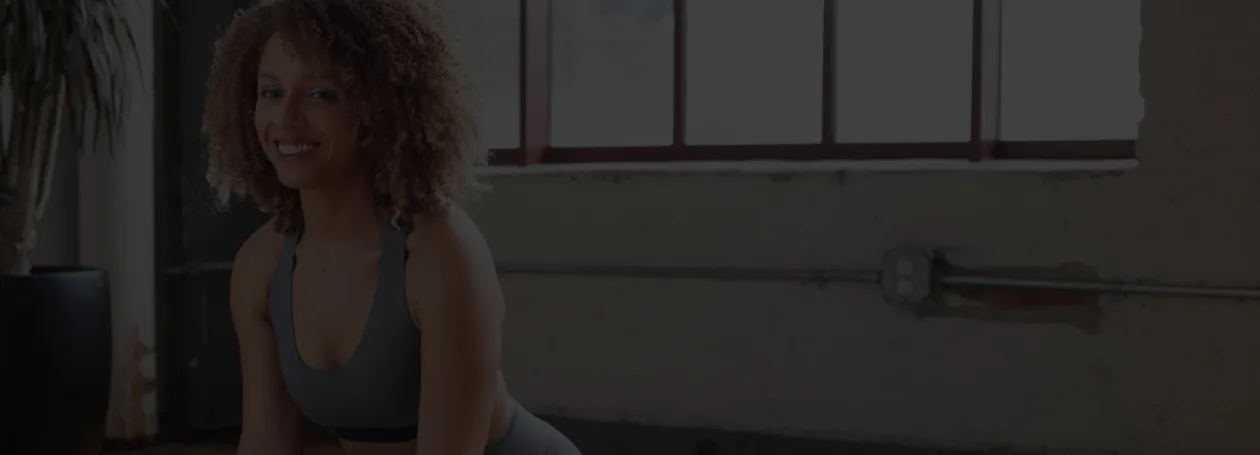
Enjoy a Free 1-on-1 Session with a Coach!
Receive personalized guidance tailored to your unique fitness goals, live with a dedicated coach—no credit card required.
Frequently Asked Questions
Happy Baby Pose (Ananda Balasana) gently opens the hips, releases lower back tension, and stretches the inner groin and hamstrings. It’s excellent for improving flexibility, relieving stress, and promoting relaxation before sleep.
This depends on your fitness level and comfort with hip-opening poses. Start slow, and progress gradually.
- Beginners: 30 seconds to 1 minute
- Intermediate: 1–3 minutes
- Restorative/Yin: 3–5 minutes or longer with props
The longer you hold with steady breathing, the deeper the hip release and sense of calm.
Happy Baby Pose is generally safe during the first trimester, especially when done gently or one leg at a time.
Avoid lying flat on your back after the first trimester, as it may reduce blood circulation.
For 1-on-1 guidance during pregnancy, book a free session here!
Yes! It’s one of the best poses for relaxing the nervous system and preparing for deep sleep.
Holding Happy Baby for 2–3 minutes before bed releases hip tension, soothes the lower back, and clears mental stress.
Yes, when practiced correctly. The gentle traction on the spine relieves compression and tightness in the lower back. If your pain is acute, start with the Knees-To-Chest pose and progress under supervision.
Absolutely! Happy Baby Pose is perfect for beginners. It’s simple, restorative, and easy to modify with props or straps.


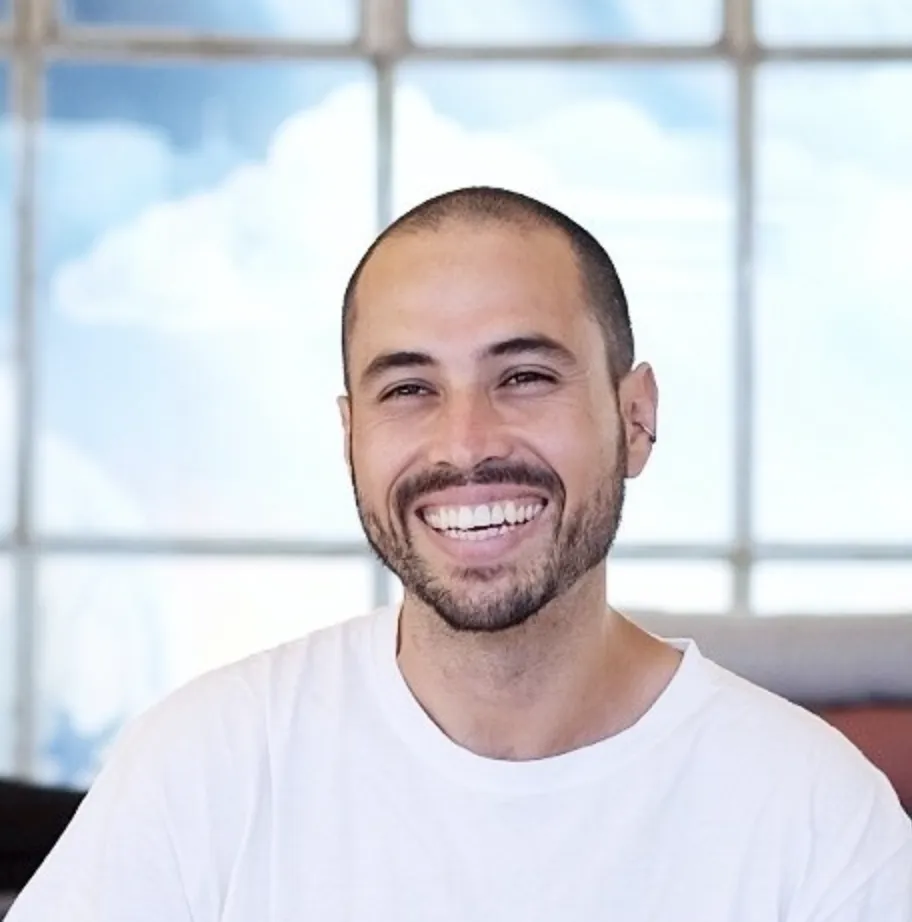
.webp)
%20(7).jpg)
